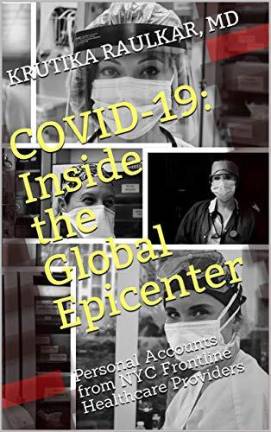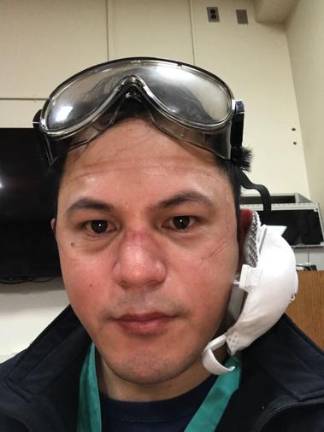Writing the Book on COVID
New York doctor provides an educational resource to the virus with firsthand accounts from frontline health care workers



When the coronavirus pandemic hit New York City, Dr. Krutika Parasar Raukar was a rotating resident in three area hospitals, one of the most affected with over 750 patients ventilated, a rehabilitation center, and a veteran’s hospital. A six-feet apart conversation with her neighbor in the hallway of their Bronx building, where she answered questions about the novel virus that plagued our city and the world, sparked the idea to put all of her knowledge down for others to reference.
What started as an informational guide, “COVID-19: Inside the Global Epicenter” ultimately came to include personal accounts from Raulkar’s co-residents, many of whom had been redeployed to the emergency department and the ICU. “One thing that struck me was just how thankful people were to have an opportunity to share their stories,” she said of the 35 interviews she conducted. “Some people had told me they’ve never actually shared this with anyone yet and it was kind of a way for them to decompress.” As of now, it is seemingly the only book of its kind that sheds light on health care providers’ experiences.
The comprehensive guide is filled with critical information to help readers navigate the illness, such as the efficacy of testing methods and treatments. It also explains the pandemic’s lasting impacts on the healthcare system and economy, and how evidence from the past implicates that a second, even stronger wave is possible.
Specializing in physical medicine and rehabilitation, Raulkar also stresses the importance of the not-so-frequently-spoken-about six to eight weeks of rehab COVID patients must face after being discharged. “People see the death rate, but they don’t actually see the rate of people who are severely injured and have these long-lasting side effects. I do think that most of them will recover pretty well, but it will take a long time.”
After they recover from COVID, patients are transferred to the rehabilitation unit. Tell us about what you saw there.
A lot of it was critical illness, neuropathy, because a lot of these patients were proned [turned on their stomachs], so they had prolonged time of compression of their nerves. We also saw problems with patients’ cognition, which could be a post-viral syndrome or a direct effect of the virus, it’s still not quite known. Then of course, just deconditioning. For every day that you’re in the hospital, you lose about one to two percent of your muscle mass. And people who were intubated for two months were very deconditioned.
What is one interview that stayed with you?
One was with Eugene Palatulan, one of my co-residents who was redeployed to the emergency department. He has two young daughters and his wife is pregnant and had to work from home while taking care of their daughters. And he was quarantined from them because he didn’t want to pass the virus on to them. I think that’s a really good example of a health care worker’s fear for his family and having to sacrifice family time. He was in the ED at the peak of the pandemic, in one of the most affected hospitals in the world with thousands of cases and over 750 ventilated patients at the peak. Dr. Palatulan described hundreds of patients pouring into the ED. Many were in the hallways due to lack of available rooms. With COVID-19, patients’ oxygen saturations could drop precipitously to dangerously low levels and yet the patient could be conversing normally. One of the things we learned is that in the beginning, we were intubating people way too early because we followed typical acute respiratory distress [ARDS] guidelines. We found early intubation wasn’t benefiting COVID patients and proning became a huge strategy.
You talk about how human connection was lost because of all the PPE and the fact that patients’ families couldn’t be there. However, you gave examples of how health care providers tried to compensate for that.
I think the family being at the patient’s bedside is one of the most important parts of the patient’s care, especially for those who are incredibly debilitated in the rehab unit. I had patients who told me they were much more anxious and depressed just being alone there for a lot of the day. We definitely tried to talk and spend more time with them, but you didn’t want to stay in the patient’s room exorbitantly because you didn’t want to risk giving the infection to yourself, your patients, or other people.
Also, it was just the coldness of wearing all of this gear and them not seeing your face or feeling your touch. Some of the strategies we did to overcome this was calling the family much more frequently, trying to do FaceTime and video chats between the patients and family members. I heard from some of my colleagues that when the patient was dying, in those severe instances, they called in the family and had them be with them in those last moments.
If not implemented correctly, the swab test, which is used to see if you are infected at that moment, could give false results?
Yes, it’s very important that it’s done correctly and it’s very uncomfortable for patients, so they often ask you to perform it incorrectly. A lot of them have told me, “Can you just do one nostril? Please don’t go that deep inside.” But technically to do it correctly, you have to go for ten seconds in each nostril all the way to the nasal pharynx. People, we’ve seen, don’t always do it that way.
So a negative antibody result doesn’t necessarily mean you didn’t have the virus?
There are studies suggesting that the type of immunity that is more common with COVID-19 is T-cellular immunity, which is similar to other viruses such as influenza. Thus, people with milder cases may be able to fight the virus with cellular immunity, and the levels of antibodies they form may be undetectable by our antibody tests. These people could still have immunity to the virus, and thus some heavily hit areas may already be close to herd immunity.
As an undergrad at Brown, you read “The Great Influenza,” about the Spanish flu, which you frequently quote in your own book. How can we compare that pandemic, also in terms of implications for a second wave?
The biggest difference is the age of the patients, 1918 affected young people, predominately between the ages of 20 and 40, as well as pregnant women and even young children. So a lot of the doctors and nurses on the front lines who tend to be young were being killed by this. Versus this disease which predominately affects patients over age 60, but also if they have significant comorbidities, we see 50- and 40-year-olds, much less patients younger than that, with a few exceptions.
In terms of the waves, I actually think this is an important point that isn’t being talked enough about. Almost every pandemic in history has had multiple waves and in 1918, the first wave was mild. It was in the spring. People identified it as a pandemic, but it really didn’t kill as many people as the second wave, which hit in the fall. This was very lethal; it was a mutation and interestingly, the people who had already gotten the virus in the first wave had 99 percent immunity to the second wave.